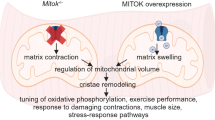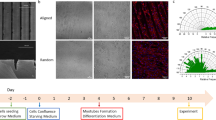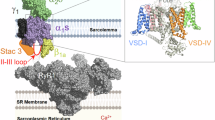Abstract
It has been known for some years that skeletal muscle develops a high potassium permeability in conditions that produce rigor, where ATP concentrations are low and intracellular Ca2+ is high1. It has seemed natural to attribute this high permeability to K channels that are opened by internal Ca2+, especially as the presence of such channels has been demonstrated in myotubes and in the transverse tubular membrane system of adult skeletal muscle2–4. However, as we show here, the surface membrane of frog muscle contains potassium channels that open at low internal concentrations of ATP (<2 mM). ATP induces closing of these channels without being split, apparently holding the channels in one of a number of closed states. The channels have at least two open states whose dwell times are voltage-dependent. Surprisingly, we find that these may be the most common K channels of the surface membrane of skeletal muscle.
This is a preview of subscription content, access via your institution
Access options
Subscribe to this journal
Receive 51 print issues and online access
$199.00 per year
only $3.90 per issue
Buy this article
- Purchase on SpringerLink
- Instant access to full article PDF
Prices may be subject to local taxes which are calculated during checkout
Similar content being viewed by others
References
Fink, R. & Lüttgau, H. C. J. Physiol., Lond. 263, 215–238 (1976).
Fink, R., Hase, S., Lüttgau, H. C. & Wettwer, E. J. Physiol., Lond. 336, 211–228 (1983).
Barrett, J. N., Magleby, K. L. & Pallotta, B. S. J. Physiol., Lond. 331, 211–230 (1982).
Latorre, R., Vergara, C. & Hidalgo, C. Proc. natn. Acad. Sci. U.S.A. 79, 805–809 (1982).
Hamill, O. P., Marty, A., Neher, E., Sakmann, B. & Sigworth, F. J. Pflügers Arch. ges. Physiol. 391, 85–100 (1981).
Standen, N. B., Stanfield, P. R. & Ward, T. A. J. Physiol, Lond. 346, 81P(1984).
Standen, N. B., Stanfield, P. R., Ward, T. A. & Wilson, S. W. Proc. R. Soc. B221, 455–464 (1984).
Colquhoun, D. & Hawkes, A. G. Proc. R. Soc. B211, 205–235 (1981).
Standen, N. B., Stanfield, P. R. & Ward, T. A. J. Physiol., Lond. 364, 339–358 (1958).
Dawson, M. J., Gadian, D. G. & Wilkie, D. R. J. Physiol., Lond. 299, 465–484 (1980).
Macchia, D. D., Polimeni, P. I. & Page, E. Am. J. Physiol. 235, C122–127 (1978).
Noma, A. Nature 305, 147–148 (1983).
Cook, D. L. & Hales, C. N. Nature 311, 271–273 (1984).
Ashcroft, F. M., Harrison, D. E. & Ashcroft, S. J. H. Nature 312, 446–448 (1984).
Boobis, L. H., Williams, C. & Wooton, S. J. Physiol., Lond. 338, 21P (1983).
Yellen, G. Nature 296, 357–359 (1982).
Colquhoun, D. & Sigworth, F. J. in Single-Channel Recording (eds Sakmann, B. & Neher, E.) 191–263 (Plenum, New York, 1983).
Gay, L. A. & Stanfield, P. R. Nature 267, 169–170 (1977).
Schwarz, W., Neumcke, B. & Palade, P. T. J. Membrane Biol. 63, 85–92 (1981).
Author information
Authors and Affiliations
Rights and permissions
About this article
Cite this article
Spruce, A., Standen, N. & Stanfield, P. Voltage-dependent ATP-sensitive potassium channels of skeletal muscle membrane. Nature 316, 736–738 (1985). https://doi.org/10.1038/316736a0
Received:
Accepted:
Issue date:
DOI: https://doi.org/10.1038/316736a0
This article is cited by
-
Expression of truncated Kir6.2 promotes insertion of functionally inverted ATP-sensitive K+ channels
Scientific Reports (2021)
-
Regulation of muscle potassium: exercise performance, fatigue and health implications
European Journal of Applied Physiology (2021)
-
Neuroprotective role of ATP-sensitive potassium channels in cerebral ischemia
Acta Pharmacologica Sinica (2013)
-
ATP-sensitive K+ channels in rat colonic epithelium
Pflügers Archiv - European Journal of Physiology (2013)
-
Current understanding of KATP channels in neonatal diseases: focus on insulin secretion disorders
Acta Pharmacologica Sinica (2011)



